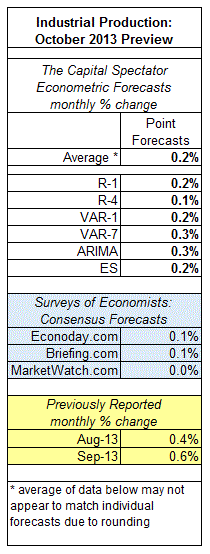Tomorrow’s October report on US industrial production is projected to post a 0.2% rise vs. the previous month, based on The Capital Spectator’s average econometric forecast. The expected gain represents a substantial deceleration vs. the increase in industrial output for September. Meanwhile, the Capital Spectator’s average projection for October is slightly higher than the estimates in several surveys of economists.
Here’s how the numbers stack up, followed by brief definitions of the methodologies behind The Capital Spectator’s projections:

R-1: A linear regression model using the ISM Manufacturing Index to predict industrial production. The historical relationship between the variables is applied to the more recently updated ISM data to project industrial production. The computations are run in R.
R-4: A linear regression model using four variables to project industrial production: US private payrolls, an index of weekly hours worked for production/nonsupervisory employees in private industries, the ISM Manufacturing Index, and the stock market (S&P 500). The historical relationships between the variables are applied to the more recently updated data to project industrial production. The computations are run in R.
VAR-1: A vector autoregression model using the ISM Manufacturing Index to predict industrial production. VAR analyzes the interdependent relationships of the variables through history. The forecasts are run in R using the “vars” package.
VAR-7: A vector autoregression model using seven variables to project industrial production: US private payrolls, an index of weekly hours worked for production/nonsupervisory employees in private industries, the ISM Manufacturing Index, the stock market (S&P 500), real personal income less current transfer receipts, real personal consumption expenditures, and oil prices. VAR analyzes the interdependent relationships through history. The forecasts are run in R using the “vars” package.
ARIMA: An autoregressive integrated moving average model that analyzes the historical record of industrial production in R via the “forecast” package to project future values of the data set.
ES: An exponential smoothing model that analyzes the historical record of industrial production in R via the “forecast” package to project future values of the data set.